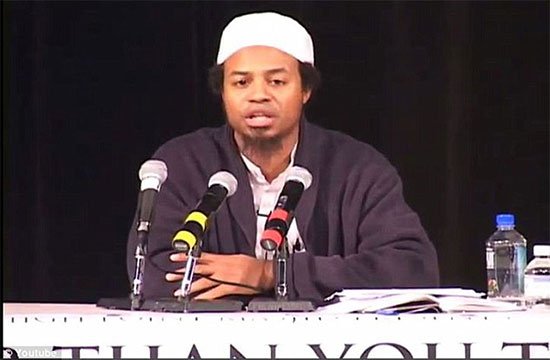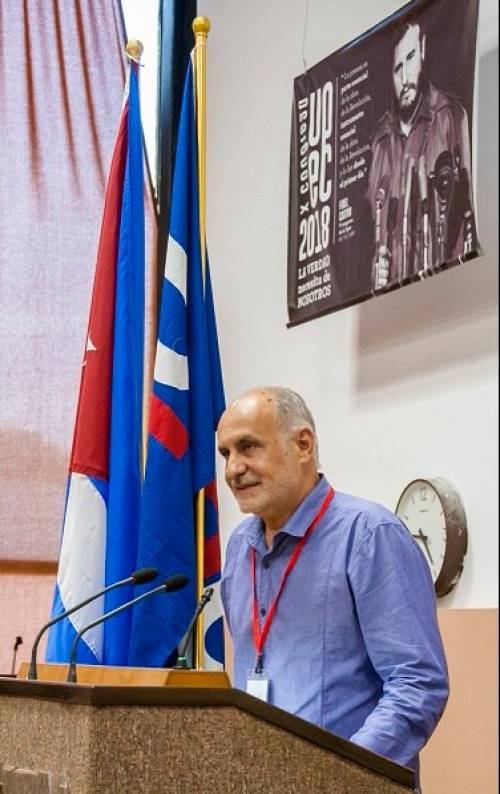Juventud Rebelde 221
Women in the Revolution
Women in the Revolution
 By: Graziella Pogolotti
By: Graziella Pogolotti
Cuban art critic, essayist and intellectual. National Literature Prize (2005). President of the Advisory Council of the Minister of Culture, Vice President of the Union of Writers and Artists of Cuba, member of the Cuban Academy of Language and President of the Alejo Carpentier Foundation.
September 3, 2018
A CubaNews translation. Edited by Walter Lippmann.

Women have ceased to be a simple object of desire, used as an instrument of the businesses that move around the beauty competitions. Photo: Miguel Rubiera.
Panchita’s face kept the indelible mark of the misery accumulated throughout a lifetime. She worked in the bookstore of L and 27 that I frequented weekly in search of the latest. Efficient, helpful without servility. In spite of the current of sympathy between us, we exchanged few words. One afternoon, however, I told her that I had spoken about her with a friend. Was it Charito? he asked with a broad, complicit smile.
That’s how it was. In fact, Charito Guillaume devoted her entire life to the needle-trades workers union struggle. This included, among others, branches of big Havana businesses, against prevailing racial discrimination in the sector, for salary improvements and in defense of the “right to the chair,” that is, the possibility of sitting when there were no clients in the area. According to her, a grassroots militant, Panchita had faced her son’s upbringing in solitude. Hers was not, however, an isolated case.
Cuban women can proudly tell a story that makes us precursors in more than one field.
In these times of open discussion about our Draft Constitution, it is right to evoke the profile of Ana Betancourt, an early defender of our rights in the Guáimaro Assembly. Many shared the harsh conditions of the Mambi camps. Mariana Grajales was prepared to offer her children to the struggle for the conquest of an independent nation, liberated from the infamous slavery and its racist aftermath. On the verge of waging the necessary war, José Martí noted the gesture of Manana, Máximo Gómez’s wife, with emotion. In offering him some help in the face of imminent helplessness, the wife of the great strategist stated that she would ask nothing from the revolution.
Throughout the neocolonial Republic, Cuban women continued to fight for their rights, inseparable from the fundamental battle in favor of the Revolution. Recently, Granma took up again the famous chronicle in which Pablo de la Torriente Brau evoked the death agony of Rafael Trejo, still smiling. “This boy cannot be saved,” commented the doctors as they struggled to defend that young, promising life that had become the most valuable symbol of the revolutionary student body.
When the inevitable outcome occurred, the women disputed the honor of shouldering the heavy coffin. In the fight against Machado, they challenged the police in the street demonstrations. When I try to rescue in my imagination that scenario full of violence, I like to remember that, among so many others, there was our “charming damsel”, the refined Esther Borja, then an education student and future interpreter of Ernesto Lecuona. When the dictatorship fell, we obtained the right to vote.
Faced with Batista’s coup, in addition to prominent fighters such as Haydée, Melba, Celia and Vilma, thousands of women mobilized in resistance to the dictatorship. Many of them fulfilled their mission and divoted themselves to diverse tasks in favor of the transformation of society. There is much to investigate and write about this beautiful story. Because, in spite of what has been conquered, much remains to be done.
Vilma’s leadership of the FMC took into account Cuban reality, and the legacy it had received. She looked at the problems of the future, objective and subjective – and therefore cultural. These had to be overcome immediately, as well as in the long term, in the light of the evolution of society as a whole.
It was urgent to overcome accumulated backwardness, especially for farmworker women. It was necessary to encourage access to work, to promote professional development in all branches of knowledge, to protect motherhood and the upbringing of women workers’ children. With patience and wisdom, it was indispensable to file the deleterious legacy of machismo, often unconsciously assumed as a natural fact by the women themselves.
The Family Code, sex education and the legalization of abortion placed us at the forefront of international debate in this field. Owners of their own destiny, women ceased to be simple objects of desire, used as an instrument of the businesses that promote beauty contests.
Recently, a Cuban television colleague suggested that, on the occasion of the carnivals, the idea of choosing the star should be taken up again. He argued that this is an internationally-established custom. We must be open to the world for all the useful learning it can offer. However, we cannot adopt customs that imply a regression from the conquests reached. This is all the more so in complex circumstances that introduce shadows of bad memories into our society.
In more than one sense, there are expressions that reflect the resurgence of machismo. On the other hand, in something strictly cultural, the changes introduced years ago in the carnival celebrations truncated a deeply-rooted popular tradition. Few people know that the one in Havana was the oldest in our country. The comparsas, as in Rio de Janeiro, emerged from the soul of the neighborhood. They took a long time to prepare, choosing the design of the steps, the wardrobe, and to develop the exceptional skill of the bearer of the lantern. I still remember when, at the side of La Punta, the drummers were warming up.
The comparsa was the result of a collective creation. In it the sense of belonging was settled. It was the manifestation of a living folklore. Because of its popular essence, it emerged from the bottom up to be delivered to thousands of spectators.
The massive use of women as sexual objects, a commercial phenomenon widely promoted by the media, has had disastrous consequences in all countries. To the hypertrophy of the quinceañera celebration, in some places have been added the so-called mini-quinces. These deform the developmental process of the child’s personality which have given rise to tragic phenomena of pedophilia. In some countries, this has gone to the point of demanding application of penal measures against the media which contribute to the diffusion of the phenomenon.
Let us not fall into easy temptations. Let us observe the world around us and carry out the indispensable critical exercise stripped of complacency, about what is proper and lucid as to what is essential among the inalienable values that we must defend.
(Taken from Juventud Rebelde)
Uri Avnery: “no fear, no prejudice”

Uri Avnery and a legacy “without fear, without prejudice”
The Israeli fighter for the Palestinian cause died in Tel Aviv on Monday.
 By Marylín Luis Grillo
By Marylín Luis Grillo
digital@juventudrebelde.cu
Posted: Monday 20 August 2018 | 09:11:00 PM
A CubaNews translation. Edited by Walter Lippmann.

Avnery leading a march for the two states, Israel and Palestine. Author: Gush-Shalom Published: 20/08/2018 | 09:04 pm
This August 20, the Palestinian cause has lost one of its greatest defenders. Uri Avnery – a journalist, intellectual, former member of parliament, a man of the left and of peace – died at the age of 94, ten days after suffering a stroke, in a hospital in Tel Aviv.
As a Jew in Nazi Germany, he had to flee in 1933 to Palestine, then a British colony. He saw Israel born, and, at the dawn of a mad youth, he was a Zionist guerrilla against the Arabs and fought with the Israeli army. However, his whole subsequent life was spent trying to create a stable territory in the Middle East and he strongly advocated the two-state solution within his own country.
“There were less than a hundred of us in the world who defended this idea in 1949,” he said in 2011, referring to the proposal to create a Palestinian state that would coexist with Israel, “but today the whole world supports it, as do the majority of Israelis.
“No fear, no prejudice.” With this slogan and from the strength of journalism, Avnery broke the taboos of Israeli society with his weekly Haolam Haze (This World), in which he defended peaceful coexistence with Palestinians and Arabs.
For his country’s own government, its lyrics were “public enemy number one”, as the Shin Bet, Israel’s internal security service, put it. The newsroom suffered several attacks with firebombs and explosives, and was the victim of censorship and personal attacks.
In 1965 he established the left-wing political movement Haolam Hazeh-Koah Hadash, known as Meri, with whom he became a member of the Knesset (Parliament) from 1969, and in 1979 he regained a seat as a founding member of the left-wing Sheli party.
His political activities defended religious freedom in the Jewish state, civil marriage, appealed for the denuclearization of the Middle East and the rights of homosexuals, who were then forced to conceal their identity. He advocated a formal constitution.
Then, with the Oslo Peace Accords, he created Gush Shalom (Peace Bloc) in 1993, which distinguished itself from other Israeli peace movements by demanding the return of Palestinians expelled during the creation of Israel in 1948.
As a politician and journalist he was a person who took risks. Therefore, in these days when many remember him, Uri Avnery will be particularly remembered for his interview with Palestinian leader Yasser Arafat, in 1982, in Lebanon, during the Israeli siege of Beirut.
Avnery went through his own ranks to talk to Arafat for about two hours. They would meet on other occasions. It would be a clear sign that peace knows no ethnicity, religion or nationality. Avnery would defend him (Arafat) as a companion, it would even be willing to give his life for him, in 2003, when he did not hesitate to serve him together with another compatriot as a human shield in the face of the imminent danger of an attack on the Palestinian leader.
His struggle, that of the man of letters and strength, was the struggle of a discontent with injustice and, above all, of a convinced “optimist”, the title he would give to his autobiography. He published a dozen books and received many international awards. He was also beaten up by his own country, which he criticised with the conviction of believing in “the capacity of these people to change course”.
He laid the foundations for critical journalism in Israel, for political dissent, the Tel Aviv press has had to acknowledge. “Ideological rivalries are disappearing in the face of their will to build a free and strong society,” said Israeli President Reuven Rivlin of the conservative Likud party of Prime Minister Benjamin Netanyahu. While Ayman Odeh, leader of the Joint Arab List party in Israel, honored the memory of “a man who dedicated his life to peace and the creation of a Palestinian state”.
His death occurs in dark moments of heavy repression in Gaza and the West Bank, of apartheid and extermination. It may seem like goodbye, but Uri Avnery was an eternal optimist and his struggle continues on both sides of the wall.
Beauty at Any Cost?

Beauty at Any Cost?
The alarm is triggered when health risks are evident when taking on styles and habits that are, far from guaranteeing beauty, touching us with danger.
 By Ana María Domínguez Cruz
By Ana María Domínguez Cruz
digital@juventudrebelde.cu
Posted: Tuesday 07 August 2018 | 09:06:12 PM
A CubaNews translation.
Edited by Walter Lippmann.
When it comes to a haircut, a bold nail polish or a bold piece of clothing, it’s not as worrisome, because of the ephemeral nature of fashion, in the end. The alarm is triggered when health risks are evident when assuming styles and habits that far from guaranteeing beauty, touch us with danger.

Beauty, idealized perfection, belonging to a social group that makes them feel accepted, respected and proud are pursued. Author: Twitter Posted: 07/08/2018 | 08:42 pm
Several blogs dedicated to fashion and pseudo beauty, as well as photos, have multiplied in social networks, promoting a series of aesthetic fashions, based on extreme thinness and non-professional criteria. Examples: the bikini bridge, thigh gap, diastema, belly-button challenge and ab-crack, among others.
During the summer, in particular, the fashion of slimming the belly until the rubber on the bottom of the bikini becomes so tight between the hips has spread so far. The textile piece then forms a bridge over the navel that can only be achieved when adolescent girls practice arbitrary diets without any balance or with excessive fasting periods.
When we talk about a thigh gap, it is because we also test our body’s strength by trying to make the upper part of the thighs so firm and thin that it leaves a clear space between them and the pubic area. Specialists warn that this is very dangerous, because, to obtain this separation of the calves from their inner faces, depends on the anatomy of the hips and not on the amount of muscle or fat in the leg, girls often resort to anorexic behaviors that put their nutritional needs at risk.
The furrow of separation between the two muscles of the abdomen in a well-marked way is another tendency between adolescents and adults, called the “ab-crack”. They do not take into account the risk of obsessive hyper-musculation from unbalanced protein intake, or in some cases, from abuse of vitamin supplements and other less-desirable substances.
As if that weren’t enough, there are plenty of images on Instagram and Facebook of teenagers who want to show off their slender bodies, running one arm behind their backs to try to touch their bellybuttons with their hands, while with their other hand they take on a selfie. The belly button challenge also certainly flirts with dangerous diets and eating disorders, as does the so-called collarbone challenge, another challenge for teenagers who want to demonstrate that they can fit a string of coins in the gap between their collarbone and their neck.
For both the female and male sexes, the diastema is now spreading as a fashion, which is nothing more than the search for the separation of the upper denture into two halves after a widening of the central teeth. It is then valued to undergo an expensive dental operation to wear what is not naturally available.
In the area of cosmetic surgery, we note with concern the fact that some teenagers between the ages of 13 and 16 want to undergo labiaplasty, an aesthetic operation that seeks to resize the vaginal lips and leave them shorter, more even or more turgid.
The followers of this surgery for aesthetic purposes consider preventive reasons regarding hygiene or pain when having sexual intercourse, as well as psychological reasons when the lips are asymmetrical and when sexual acceptance and self-esteem disorders are associated, but what is alarming is that this type of operation is not recommended before the age of 18, since the vaginal lips during adolescence are in full growth phase.
Also not without risks, and also associated with high prices is the pubic lifting, another practice used by girls and boys who want to attract more from a sexual point of view to their partners. They are exposed to lightening the adipose tissue of the Mount of Venus in women and the lower abdomen in men to rejuvenate the urogenital area.
How many wrong associations with beauty! Imitating aesthetic models that are far removed from what is healthy only shows the vulnerabilities that those who do not feel completely satisfied with their physique and way of being suffer during adolescence.
It is a complex period in life, say psychologists and sociologists, because adolescents need to build their identity and value the opinion that others have of them. However, this is the best time to alert them to the health consequences of certain behaviors and, above all, to the importance of accepting themselves and cultivating what may be invisible to the eyes, but which is ultimately the most valuable.

Diastema: In search of the unnatural separation of the teeth the person undergoes the risks of dental surgery.

Ab-crack: Teens do not take into account the risk of obsessive hypermusculation from unbalanced protein intake.
Chucho Valdés album dedicated to his father

Chucho Valdés will release an album dedicated to his father
Chucho Valdés: I dedicate the album to my father because this year is the centenary of his birth, he was the first one to insert the batá drums in a Big Band, creating the so-called batanga rhythm.
By Juventud Rebelde
digital@juventudrebelde.cu
Posted: Thursday August 9, 2018 | 12:39:36 PM
A CubaNews translation.
Edited by Walter Lippmann.
Cuban jazzman Jesús “Chucho” Valdésut confirmed on Wednesday that he will release the album Jazz Batá II, a recording dedicated to his father, also a jazzman, Bebo Valdés, in October.
“I dedicate the album to my father because this year it is the centenary of his birth. He was the first to insert the batá drums in a Big Band, thus creating the so-called batanga rhythm”, said the multi-awarded pianist in a press conference, according to PL.
One of the songs I include in the recording, he said, “I played it when I was a kid, and many years later I played it for him and I didn’t remember it, I called it 100 years of Bebo.
Another new development from the Cuban jazz musician is the project “Chucho en buena compañía” (Chucho in good company), a series of concerts that he will offer in August each year, starting in 2019, in Havana with special guests.
It will be something special, he said, and I already have plans to start with Wynton Marsalis, Herbie Hancock, and Chick Corea, said the winner of six Grammy Awards and three Latin Grammy Awards.
Valdés is in the capital of the island to present in concert the album “Once. Concierto para dos”, which he recorded with the Argentine singer Patricia Sosa.
Both of them will take to the stage of the Gran Teatro de La Habana “Alicia Alonso” on Saturday, August 11 to perform the songs on the album. The Cuban will also present solo themes, and with a special character they will share a few themes with Omara Portuondo.
Where do Assassins Come From?
- English
- Español

Where do Assassins Come From?
The imam who inspired the Orlando assassin was a homophobic ex-Marine and former FBI agent
14 June 2016 22:36:33 CDT
Translated and edited by Walter Lippmann for CubaNews.
 Marcus Dwayne Robertson was undercover FBI agent for 15 years.
Marcus Dwayne Robertson was undercover FBI agent for 15 years.
Author: dailymail
WASHINGTON, June 14.- Omar Mateen, Orlando’s killer, was a follower of Marcus Dwayne Robertson, a former imam who preached hatred of homosexuals.
Robertson, 47, has a past that raises more than one question about the effectiveness of U.S. intelligence controls of suspected terrorists, ANSA said.
The imam, who was allegedly interrogated Sunday along with other colleagues, has been known to law enforcement since 1991, when he was first arrested, Foxnews reported.
This is an American ex-marine who later became the leader of a New York gang known as Ali Baba and the 40 thieves, considered responsible for robbing more than ten banks, post offices and houses, as well as shooting three policemen.
At that time Robertson served as a bodyguard for Omar Abdel Rahman, known as “The Blind Sheik,” who led the terrorist group that attacked the World Trade Center in 1993.
But after his arrest, along with others in the gang, the plaintiff reached an agreement with Robertson: a sentence of only four years in prison, before working as an undercover agent for the FBI to document terrorist plans and networks in Africa, Egypt and the United States.
In 2011, Marcus was re-arrested and sentenced to four years for fiscal fraud and violation of the weapons law: his goal was to pay for a Mauritanian student’s trip to teach him how to be a terrorist.
The prosecution asked to add another ten years for his links to terrorism, but district judge Gregory Presnell released him last year.
During his detention he was confined to solitary confinement because he was suspected of having radicalized at least 36 prisoners.
Robertson launched a seminar on Islam, via the Internet: a spiritual school frequented by Omar Mateen that may not have been the only source of inspiration for the author of the Orlando massacre.
In fact, Mateen was in the Islamic center of Fort Pierce with Imam Shafig Rahman two days before the attack, according to The Washington Post.
This mosque was also frequented by Monar Abu Salha, also known as Al-Amriky (the American), considered the first with that nationality to commit a suicide bombing in Idlib, Syria, in 2014, as a militant of a group linked to al-Qaeda.
Mateen and Abu Salha knew each other and this relationship led the FBI to interrogate the former in 2014, though without judicial follow-up.
Imam Rahman confirmed that Omar “prayed in the mosque three or four times a week” and took part in the evening ceremonies, recently even “with his little son”.
Orlando’s killer was not very sociable: “Once the prayer was over, he left, he didn’t socialize with anyone. He never seemed like a violent person,” Rahman said.

¿De dónde vienen los asesinos?
Un homofóbico exmarine y exagente del FBI, el imán que inspiró al asesino de Orlando
 Marcus Dwayne Robertson fue agente encubierto del FBI durante 15 años.
Marcus Dwayne Robertson fue agente encubierto del FBI durante 15 años.
Autor: dailymail
Juventud Rebelde
digital@juventudrebelde.cu
14 de Junio del 2016 22:36:33 CDT
WASHINGTON, junio 14.— Omar Mateen, el asesino de Orlando, era seguidor de Marcus Dwayne Robertson, un exmarine devenido imán, que predicaba el odio contra los homosexuales.
Robertson, de 47 años, tiene un pasado que plantea más de una interrogante sobre la eficacia de los controles a sospechosos de terrorismo por parte de los servicios de inteligencia estadounidenses, dijo ANSA.
El imán, quien habría sido interrogado el domingo junto a otros colegas, es conocido por las fuerzas del orden desde 1991, cuando fue arrestado por primera vez, informó Foxnews.
Se trata de un exmarine estadounidense quien luego se convirtió en jefe de una banda de Nueva York, conocida como Alí Babá y los 40 ladrones, considerada responsable de haber robado más de diez bancos, oficinas postales y casas, además de haber disparado contra tres policías.
En aquella época Robertson se desempeñó como guardaespaldas de Omar Abdel Rahman, conocido como «El Jeque Ciego», quien guió al grupo terrorista que atacó al World Trade Center, en 1993.
Pero tras su arresto, junto a otros de la banda, la parte demandante alcanzó un acuerdo con Robertson: una pena de solo cuatro años de cárcel, antes de trabajar como agente encubierto para el FBI para documentar planes y redes terroristas en África, Egipto y Estados Unidos.
En 2011, Marcus fue arrestado nuevamente y condenado a cuatro años por fraudes fiscales y violación de la ley de armas: su objetivo era pagar el viaje de un estudiante de Mauritania para instruirlo como terrorista.
La acusación pidió agregar otros diez años por sus vínculos con el terrorismo, pero el juez distrital Gregory Presnell lo dejó en libertad el año pasado.
Durante su detención estuvo confinado a aislamiento porque era sospechoso de haber radicalizado al menos a 36 encarcelados.
Robertson lanzó un seminario sobre el Islam, vía Internet: escuela espiritual frecuentada por Omar Mateen y que podría no haber sido la única fuente de inspiración del autor de la masacre de Orlando.
De hecho, Mateen estaba en el centro islámico de Fort Pierce junto al imán Shafig Rahman, dos días antes del atentado, según informó el diario The Washington Post.
Esa mezquita era también frecuentada por Monar Abu Salha, conocido también como Al-Amriky (El estadounidense), considerado el primero con esa nacionalidad en cometer un atentado suicida en Idlib, Siria, en 2014, como militante de un grupo ligado a Al Qaeda.
Mateen y Abu Salha se conocían y esta relación llevó al FBI a interrogar al primero en 2014, aunque sin seguimiento judicial.
El imán Rahman confirmó que Omar «rezaba en la mezquita tres o cuatro veces a la semana» y formaba parte de las ceremonias nocturnas, recientemente incluso «con su pequeño hijo».
El asesino de Orlando no era muy sociable: «Una vez finalizada la plegaria se iba, no socializaba con nadie. Nunca pareció una persona violenta», relató Rahman.
Curiosities About the Sexual Act

Curiosities About the Sexual Act Around the World
Sexual intercourse is possibly the oldest and most universal practice in the world, but the way in which each person does it differs considerably from country to country.
By Juventud Rebelde digital@juventudrebelde.cu
Published: 03/08/2018 | 05:15 pm
A CubaNews translation.
Edited by Walter Lippmann.

Love eros is an idealized form of love, it is the passionate feeling of ecstasy experienced at the beginning of a new relationship, where passion and physical attraction are the driving forces, tends not to last in the long run. Author: Juventud Rebelde.
After research by the BBC Crossing Continents programme, she discovered fascinating facts about culture and sex.
When it comes to having sex, there’s a little bit of everything: from people who practice celibacy to those who dance with apples in their armpits as part of sexual conquest.
Some of the most striking customs are:
1. Proper names for the genitals
The ancient Hawaiians used to give their genitals affectionate names. But not only that, both royalty and commoners had their own mele ma’i, a personalized genital song.
These lyrical odes would describe the lower regions of the individual in some detail and quite broadly.
An expert on Hawaiian sexual behavior, Dr. Milton Diamond, tells how Queen Lili’uokulani’s song speaks of her genitals “frolicking, going up and down”.
2. Towards celibacy
The birth rate in Japan is declining, as are contraceptive methods such as condoms and the pill. Abortions and sexually transmitted diseases have also declined.
“The only explanation is that the Japanese are having less sex,” says Kunio Kitamura, head of Japan’s family planning association.
Recent research has shown that there are a record number of couples living in marriage without sex and that one-third of men say they are too tired to have sex.
The report notes that a quarter of women consider sex to be problematic.
Another survey, which examined people between the ages of 18 and 34, found that the proportion of virgin people had skyrocketed over the past decade: almost 45% said they had never had sex.
3. A day marked for conception
In Russia, meanwhile, the birth rate is advocated to increase, so one region of the country has introduced an ingenious way of getting the population to procreate.
The governor of Ulyanovsk, just east of Moscow, declared September 12 as Conception Day: a holiday that encourages couples to stay at home for the sole purpose of producing offspring.
Couples who have a baby nine months later receive prizes such as video cameras, refrigerators and washing machines.
4. The fish of conquest
In the small town of Mehinaku, in central Brazil, women have devised a simple way to decide between their suitors. There, the men who compete for a woman’s affection have to bring her a fish as a gift and the one who gets the biggest piece takes the girl.
5. Apples with fragrance
In rural Austria, it was traditional for women to attend a dance with apple slices under their armpits, after inspecting the men in the room, to offer the chosen one a piece of the sweaty apple.
If the feelings were reciprocal and the man also liked her, he would take a bite out of the apple…. which would certainly have a “special” essence.
6. Falling to the ground
This is a community where being clumsy on the dance floor can really help you in your conquest. The men and women of a Colombian Guajira tribe participate in a special ceremonial dance, in which if a woman causes a man to stumble during the dance, then both must have sex.
This practice gives a new meaning to the phrase “fall asleep”.
7. Holidays…. “active”
According to research by the travel company Spies Travel, Danes have 46% more sex on holiday, not to mention that 10% of Danish babies are conceived during their parents’ holidays.
As a reward for such activity on holiday days, in 2014 the travel agency offered three years of baby supplies and a child-friendly holiday to any of its customers who could prove that they had conceived during their holiday.
8. Those who practice most
According to a global survey conducted by condom manufacturer Durex, which included nearly 30,000 people over the age of 16 in 26 different countries, Greece is the place to be.
Travelers and Tourists

Travelers and Tourists
 By Graziella Pogolotti
By Graziella Pogolotti
digital@juventudrebelde.cu
A CubaNews translation.
Edited by Walter Lippmann.
The large-scale tourism industry has a relatively recent history. Its initial impulse came after World War II. The rise of left-wing movements and the pressure exerted by powerful trade unions led many countries to pass laws making paid rest compulsory. For many sectors of the middle classes, the possibility of enjoying holidays was opened up.
At the same time, numerous publications disseminated the cultural values located in Third World countries. Appropriate marketing operations designed tours to famous places for destinations that were docile to the indications of trained guides. The trip was no longer an adventure. Everything was planned in advance. Back home, the tourist would not remember much of the experience lived in the pyramids of Teotihuacán, but would arrive with a bunch of trinkets billed as souvenirs.
The traveler, on the other hand, is moved by the search for the unusual. He’s going to go to some of the most remote places in the cities. You will observe the human landscape without disdaining typical foods in some modest restaurants. I confess to having belonged to this species in my younger years. When I couldn’t afford the pennies to take on bigger adventures, I decided to start at home.
At the time, I had just finished my college degree. The studies of Art History had revealed to me the importance of our colonial legacy. I obtained the assistance of two compañeras to launch us on the adventure of discovering Trinidad. We stayed in a room on the corner of Media Luna and Desengaño. The names of the streets, such as the Habaneras of Amargura, Mercaderes, lficios or la Muralla have always exerted on me a remarkable power of poetic evocation. But the Trinitarian atmosphere of those days was far from what we know today.
There were the houses of yesteryear in the midst of an impressive misery. Barefoot and ragged, the children roamed the streets, sometimes reduced to begging. The ruin of the Valle de los Ingenios plunged the city into a poverty in which some families tried to preserve the dignity of the past.
It’s been a few years. In the 60’s of the last century, in the middle of the fight against the bandits, a traveling library went along the road between Cienfuegos and Trinidad. It offered book loans for children and adults. I wanted to know the experience in a direct way. The newly-literate peasants encouraged their children to acquire the habit of reading. On that occasion, I met a unique character.
Carlos Joaquín Zerquera was one of those local historians who narrated countless anecdotes of characters from the past. He did it so neatly that his murky marriage intrigues seemed to be happening in the contemporary world. His energies were focused on the effort to rescue the Brunet Palace in order to turn it into the Romantic Museum. Resources were scarce.
Nicolás Chao, Party secretary in the region, who also sponsored the creation of the Grupo Escambray, led by Sergio Corrieri, was able to listen to the Trinitarian researcher’s homily. Little by little something was done. Recognition of the need to preserve our heritage was beginning to take shape. We did not know, in those distant 1970s, that we were investing in a future tourism that would become one of our options for economic growth. Trinidad has been reborn and has recovered its best artisan tradition.
The traveler can enjoy the uniqueness of its urban environment. Let us take great care of your specific features. Let us not fall into the mimetic temptation of Cancunizing it.
On holiday days, we can try the adventure of discovering our country. Sometimes, you don’t have to walk very far to stumble upon the surprise of the unusual. In the Havana municipality of Cotorro is the Church of Santa María del Rosario, a rural place devoured yesterday by the galloping growth of the capital. Nicolás de la Escalera, the oldest painter with a name registered in our history of art left his mark there.
In our small country, there are many corners to be rediscovered. To do this properly, we need to move, relentlessly but steadily, towards a change of mentality. Let’s not confuse the popular with the uncouth. Let us discard the reductionist vision of culture as an ornament and recognize in it the nourishing source of a spirituality that defines our uniqueness, that is, our identity. Managing with intelligence, avoiding the banal commercialization of the peddlers, is a good that can translate into tangible material benefits.
Let us abandon the formal routine of commemorations. Let us make each of them an event open to wider horizons. In these days we have remembered the bicentenary of the San Alejandro foundation.
Let us abandon the formal routine of commemorations. Let us make each of them an event open to wider horizons. In those days we remembered the bicentenary of the foundation of St. Alexander. The history of the Academy was one of light and shadow. The triumph of the Revolution brought about a substantial change by bringing about the emergence of the long-neglected artistic avant-garde. The tribute to the date would be an opportunity to find in our National Museum the work of those who passed through it along with the insurgents who rebelled against the obsolescence of their curricula.
Welcome to the sunny days and the beach, as well as the festivities that animate summer days. Let us also learn to take advantage of the weeks of rest to turn our gaze inward and devote some moments to productive meditation.
Vietnamese to produce menstrual pads

Vietnamese company will manufacture sanitary pads and diapers in Cuba
In the first quarter of 2019, the production of sanitary pads and disposable diapers will begin in the Mariel Special Development Zone (ZEDM), the Vietnamese company Thai Binh Investment Trading Corp.
By Juventud Rebelde
digital@juventudrebelde.cu
Posted: Monday 26 March 2018 | 11:09:09 PM
A CubaNews translation.
Edited by Walter Lippmann.
In the first quarter of 2019, the Vietnamese Thai Binh Investment Trading Corp, which has been operating in the Mariel Special Development Zone (ZEDM) since 2016, will start producing sanitary pads and disposable diapers.
In a statement to the Cuban News Agency, Vi Nguyen Phuong, director general of the consortium, said the factory, which is currently under construction, will produce 40 million diapers and 150 million sanitary pads annually.
The investment, which totals more than nine million dollars, aims to provide local consumers with high quality, Cuban-made items, said Thai Binh, a company that has been present in the country for almost 20 years.
To meet the growing demand from domestic customers, the company decided to expand its investment activities in the ZEDM, where it also plans to build a powder detergent plant with a capacity of 50,000 tons annually, the directive said.
He argued that this new project will be under the form of a joint venture, in partnership with the commercial company Industrias Nexus S.A. of Cuba, a proposal that they plan to submit to the Mariel Office next April to become operational in 2020.
Today, Vietnam is Cuba’s second largest trading partner in the Asia-Pacific region and its main supplier of rice. The two countries have a relationship of more than half a century, which will be strengthened by the visit to Cuba of Nguyen Phu Trong, secretary general of the Communist Party of Vietnam, from 28 to 30 March.
Cuban Journalists Elect New UPEC President

New President for UPEC
Ricardo Ronquillo Bello, deputy editorial director of our newspaper, was elected on Saturday as the new president of the Union of Cuban Journalists.
Published: Sunday 15 July 2018 | 01:32:49 AM
By Juventud Rebelde
digital@juventudrebelde.cu
A CubaNews translation.
Edited by Walter Lippmann.
 Ricardo Ronquillo Bello, deputy editorial director of our newspaper, was elected on Saturday as the new president of the Union of Cuban Journalists.
Ricardo Ronquillo Bello, deputy editorial director of our newspaper, was elected on Saturday as the new president of the Union of Cuban Journalists.
In this responsibility, and by decision of the delegates to the meeting, he will be accompanied, as first vice-president, by Rosa Miriam Elizalde Zorrilla, member of the presidency of the trade union organization during the previous period, as well as Ariel Terrero Escalante, director of the International Institute of Journalism José Martí, and Jorge Legañoa Alonso, deputy director of the Cuban News Agency, as vice-presidents.
Raúl Garcés Corra, dean of the Faculty of Communication at the University of Havana; Arleen Rodríguez Derivet, journalist for the television program Mesa Redonda; and Ana Teresa Badía, Angélica Paredes López and Minoska Cadalso Navarro, all from Radio Rebelde, were also elected as non-professional members.
The Evil of the “Four Cats”

The Evil of the “Four Cats”
Explaining the reason why things happened, their meaning and importance, with solid arguments, were reasons that were countlessly laid out during the 9th Congress of the organization at the Technological University of Havana José Antonio Echeverría (Cujae).
 By Yuniel Labacena Romero
By Yuniel Labacena Romero
Posted: Thursday 14 June 2018 | 10:57:52 PM
digital@juventudrebelde.cu
A CubaNews translation.
Edited by Walter Lippmann.

We must banish apathy and increase participation. Author: Juventud Rebelde Published: 14/06/2018 | 10:36 pm
It is necessary to explain to the students the reason for things, their meaning and importance, and to do it with solid arguments, so that they know why they should attend the activities or be part of the processes or movements that the University Student Federation (FEU) has.
This was reiterated countless times during the 9th Congress of the organization at the Universidad Tecnológica de La Habana José Antonio Echeverría (Cujae).
As Felipe Alejandro Pérez, a student at the School of Automatics and Biomedicine, explained, apathy must be banished, increasing participation. And that can only be achieved by “infecting young people with the desire to do, with perseverance and personal example, having brigade leaders who motivate, convince, take on any sacrifice and strip themselves of inertia and formalism,” he said.
There were not a few participants who, like this young man, alluded to the fact that many times in the brigade, in the department and even in the university, activities are organized or certain tasks are called for and only three or four cats go, as they say in good Cuban. Faced with this reality, the student said, we have to better organize our processes.
In the same vein, Danhiz Díaz Pereira, president of the FEU in Cujae, stressed that the brigade is the essential cell of the organization and “in all our actions it has to be the most effective”. She added that the commitment of the members of the Federation is to make it more like them, through conscious and real participation in all processes.
Another topic of analysis was the Educating for Love initiative. It has been involving university students in alleviating teacher shortages in a number of provinces for several years. Yeslaisy Grandales Ferrales, a student at the Department of Mechanics, referred to this task as the most humane, far-reaching and socially-influential one in which she has participated, which means educating the new generations.
Olga Lidia Tapia Iglesias, a member of the Secretariat of the Party Central Committee, said that this task of impact, like others carried out by the FEU, demonstrates her concrete contribution to the economic and social development of the country. “Every day, she stressed, we have to think about how to become more useful, how to continue training a competent professional, who carries feelings, values and principles in keeping with the Revolution.
Not a few agreements emerged from the discussion: to promote university-industry relations that make it possible to train students in their skills. To propose to the departments that they hold a workshop on job placement, to analyze the need for the years in which the student is an assistant to be counted as seniority in the teaching category process and to strengthen other aspects of political-ideological work with new communication codes.
At the end of the meeting, Raúl Alejandro Palmero, president of the FEU, called on the students to act with the example and commitment of José Antonio Echeverría, and above all, to participate, because where it is not possible for the young person to get involved, share and motivate himself, the FEU loses its meaning, while if the opposite is achieved, the organisation becomes green.
“These are times to have a living Federation, which will continue to represent its members and do for the country,” he said.
TRANSLATION NOTE:
“Four cats” is a Cuban slang expression used when only a few people or none show up for an organized event. I’ve no idea what significance, if any, the number “four” has in this context.
Subscribe to Blog via Email
| M | T | W | T | F | S | S |
|---|---|---|---|---|---|---|
| 1 | 2 | 3 | 4 | 5 | 6 | |
| 7 | 8 | 9 | 10 | 11 | 12 | 13 |
| 14 | 15 | 16 | 17 | 18 | 19 | 20 |
| 21 | 22 | 23 | 24 | 25 | 26 | 27 |
| 28 | 29 | 30 | 31 | |||








You must be logged in to post a comment.